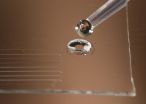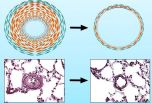Of course, the effort was hardly so simple as doubling up. The scientists had to pick specific medications that precisely countered the cancer cells' moves. Essentially, Keri and her colleagues used one medicine, rapamycin, to stop the cancer cell growth, and a second one, dasatinib, to trick the cancer cells into thinking that the original growth was still proceeding apace.
The scientists selected the drug rapamycin, an inhibitor of the protein mTOR (mammalian target of rapamycin), and dasatinib, a drug that blocks Src-family kinases (SFKs). Interestingly, neither drug, when used alone, has demonstrated significant clinical efficacy in treating breast cancer. Ongoing clinical trials combining dasatinib or rapamycin with other therapies have been promising; however, this study is the first to show that the combination of these two drugs may be beneficial in treating breast cancer.
Here is how cancer cell growth works and how rapamycin and dasatinib interrupts the process. mTOR sends signals calling for the hyperactive growth of cells characteristic of cancer. If mTOR signals are blocked, another protein, AKT (protein kinase B), takes over and signals cancer growth and survival to continue. SFKs also work in concert with mTOR and AKT in sending signals to promote tumor growth as well.
Researchers in the Keri lab found that the drug dasatinib blocks SFKs from sending signals, and without the SKF signaling, AKT does not get the message that mTOR signaling has been shut down by rapamycin. Therefore, AKT does not know to step in and take over mTOR's job in sending the necessary signals for tumor growth to continue.
"We found if you put the two drugs together, you have much better ability to kill tumors than applying either drug alone," Keri said. "That's the major discovery. Prescribing both is much better than just selecting one or the other."
Investigators used two different mouse models of breast cancer to demonstrate the efficacy of this drug combination. Magnetic resonance imaging (MRI), the same type of imaging that follows patients' tumors, was performed periodically to visualize tumor growth. When the mice eventually developed tumors, one group received the dual treatment with rapamycin and dasatinib, another group with rapamycin alone, still another group with dasatinib alone and a final group with placebo.
In the combination rapamycin and dasatinib treated group, tumors either shrunk, or vanished altogether. None of the mice in this group experienced tumor growth while receiving dual treatment. In contrast, mice in the treatment groups receiving either drug alone experienced continued tumor growth. In the placebo group, tumors grew rapidly throughout the course of the study.
Worse, when treatment was stopped in the groups receiving the single drugs, the tumors grew back to their original size and even larger within a few days. When the combined drug treatment stopped, tumor regrowth was greatly delayed by weeks.
"Dual treatment clearly delays the regrowth of tumors," Keri said.
Keri and her team next hope to launch a clinical trial to determine whether this combination therapy is as effective in humans as it is in mice. The first step will be to assess whether humans can handle the combination of medications without being overwhelmed by their toxicity. For their part, the mice showed no issues with toxicity.
"We hope to see the same effect in humans that we saw in the mouse model, and ultimately, to stop, or significantly delay, tumor growth," Keri said.
INFORMATION:
Joining Keri in her investigation were lead author Jennifer L. Yori, PhD, and contributing authors Kristen L. Lozada and Darcie D. Seachrist, all of the Department of Pharmacology, Case Western Reserve University School of Medicine; Jonathan D. Mosley, MD, PhD, Department of Medicine, Vanderbilt University School of Medicine; Fadi W. Abdul-Karim, MD, and Christine N. Booth, MD, both of the Department of Anatomic Pathology, Cleveland Clinic Foundation; and Chris A. Flask, PhD, departments of Radiology, Biomedical Engineering, Pediatrics and Genetics, and the Division of General Medical Sciences-Oncology, Case Western Reserve University School of Medicine.
Their research was supported by the National Institutes of Health (CA090398 to Keri and P30 CA043703 to the Case Comprehensive Cancer Center Histology and FACS Core Facilities).
About Case Comprehensive Cancer Center
Case Comprehensive Cancer Center is an NCI-designated Comprehensive Cancer Center located at Case Western Reserve University. The center, which has been continuously funded since 1987, integrates the cancer research activities of the largest biomedical research and health care institutions in Ohio – Case Western Reserve, University Hospitals (UH) Case Medical Center and the Cleveland Clinic. NCI-designated cancer centers are characterized by scientific excellence and the capability to integrate a diversity of research approaches to focus on the problem of cancer. It is led by Stanton Gerson, MD, Asa and Patricia Shiverick- Jane Shiverick (Tripp) Professor of Hematological Oncology, director of the National Center for Regenerative Medicine, Case Western Reserve, and director of the Seidman Cancer Center at UH Case Medical Center.
About Case Western Reserve University School of Medicine
Founded in 1843, Case Western Reserve University School of Medicine is the largest medical research institution in Ohio and is among the nation's top medical schools for research funding from the National Institutes of Health. The School of Medicine is recognized throughout the international medical community for outstanding achievements in teaching. The School's innovative and pioneering Western Reserve2 curriculum interweaves four themes--research and scholarship, clinical mastery, leadership, and civic professionalism--to prepare students for the practice of evidence-based medicine in the rapidly changing health care environment of the 21st century. Nine Nobel Laureates have been affiliated with the School of Medicine.
Annually, the School of Medicine trains more than 800 MD and MD/PhD students and ranks in the top 25 among U.S. research-oriented medical schools as designated by U.S. News & World Report's "Guide to Graduate Education."
The School of Medicine's primary affiliate is University Hospitals Case Medical Center and is additionally affiliated with MetroHealth Medical Center, the Louis Stokes Cleveland Department of Veterans Affairs Medical Center, and the Cleveland Clinic, with which it established the Cleveland Clinic Lerner College of Medicine of Case Western Reserve University in 2002. http://casemed.case.edu







